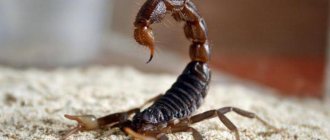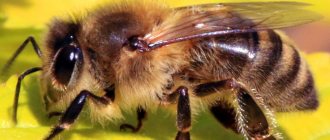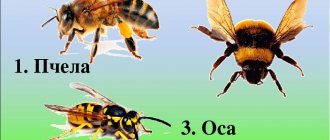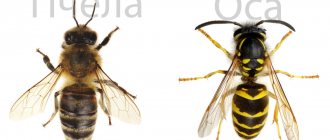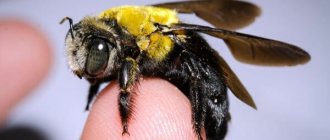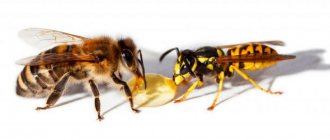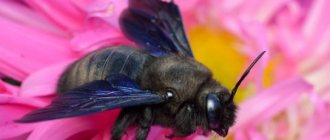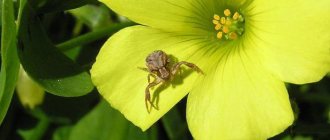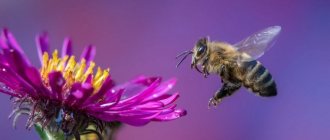Bees appeared as a result of natural and artificial selection, which people began during the development of beekeeping and beekeeping. Because of their honey, these insects are the most useful on the farm. Ancient people specially bred bees, and honey was used not only for food, but also as medicine. Bees live in different parts of the planet and are distinguished by their external characteristics, stability, productivity and other qualities.
Types of bees
At the moment, about 21 thousand bees are known, which are united in 520 genera. Let's consider the main ones:
Himalayan bee
They differ from Hymenoptera by their bright yellow-black body color. These representatives are most often found in mountainous regions. These insects are notable for the fact that they have a fairly calm character and are resistant to ticks. The honey from these bees is collected by the Gurung people of Nepal. It is noteworthy that their honey has hallucinogenic properties. This fact is due to the fact that in the territory in which they live there is a large number of rhododendrons. During the flowering period, these plants produce andromedotoxin, which is a strong poison. When it enters the human body, it contributes to the appearance of hallucinations.
Leaf Cutter Bee
The appearance of this bee is very similar to ordinary wasps. They have a body length ranging from 8 to 16 millimeters. They are distinguished by the presence of a strong jaw, thanks to which they can cut leaves. Leaf cutters feed on nectar. They can be found in latitudes where a temperate climate prevails. Over the course of a bee’s entire life, only 25 plants can be pollinated, since they have a rather short life cycle.
Bashkir bee
This species of bees is found in European countries. Their body color is gray without the characteristic yellow stripes. These insects have perfectly adapted to various climatic conditions, as they are able to fly out of the hive even in the cold.
Yellow Caucasian bee
These representatives are considered one of the most common breeds and are found in the mountains. They are capable of producing high-quality honey, but they tolerate cold extremely poorly and are endowed with poor immunity. About 7 percent of these bees have a swarming instinct.
Gray Caucasian bee
A distinctive feature of this bee is its gray color. The entire body lacks the yellow stripes that are characteristic of most bees. This representative is divided into several subspecies depending on its habitat: Abkhazian, valley, Kakheti, Imeretian and Megrelian. Insects of this species do not tolerate moving to places with a cold climate.
Italian bee
These individuals began to spread throughout the Apennine Peninsula. They are distinguished by gray, gold or three-stripe color. Golden bees are most often bred. Individuals of this species are large in size and have a trunk length of about 6.5 millimeters. Italian bees themselves are quite peaceful, but are aggressive in times of danger. It is quite difficult for them to live on the territory of Russia, since they endure winter with great difficulty.
Asian bees
Certain species of honey bees have spread to Asia. They have a number of characteristic differences. At the moment they number 9,000 species. The main representative is the large bee Apis dorsata laboriosa . In addition to their large size, the abdomen of these individuals is dark in color with white stripes. Between the main pairs of eyes there is an additional pair. These bees live on steep cliffs where they build their hives. Their bite is very painful.
Ukrainian steppe bee
Bees of the Ukrainian steppe breed are adaptive to serious temperature fluctuations, thanks to which they can tolerate wintering well. These bees prefer plants that are high in sugar. About 10% of all bees of this species are prone to swarming. They are also distinguished by good fertility and unique cleanliness, which is manifested in the fact that the hives of these bees are not clogged with debris and wax.
Don bee
This species is also characterized by fairly high fertility. Their color is represented by brown stripes. During the reproductive period, the queen lays about 3,000 eggs per day. However, members of the family are very prone to swarming. They feed mainly on the nectars of sweet clover, oregano and acacia.
Thai bees
The appearance of these bees is represented by a dark abdomen and the absence of characteristic stripes on the surface. Also, the wings of these bees are much darker. The insects themselves are distinguished by a calm character and a high degree of efficiency. Their honey is famous for its soft and pleasant taste.
Abkhazian bee
You can meet this bee in the mountainous regions of the Caucasus. They prefer to live on steep cliffs, which is why they are also called stone bees. They are widely used for breeding due to their delicious and unique honey. They are cultivated in the USA and Western Europe. This species is distinguished by its disproportionately long trunk.
Melipona bees
The peculiarity of this species is the absence of a sting. Instead, they actively use their scent glands. If attacked, the melipon bee can use its mandibles. These individuals are also notable for the fact that they do not have a specific division of labor. Their hives are similar to bumblebee nests. Melipona honey is widely used in the Yucatan Peninsula as the bees in this region produce the most delicious honey. A very small population has survived to this day.
Altai bee
This type of bee is quite rare. They are widely used in Altai to produce honey, which has a number of beneficial properties. This species is also particularly productive and carefully uses its food supply.
Siberian bee
These bees have spread throughout Siberia, making them quite frost-resistant. They are valued due to their high resistance to a large number of diseases. They are also distinguished by their rather large size and high degree of fertility.
Structure, what a bee looks like
A bee is an arthropod. The body consists of three main parts
- stomach.
- Head;
- Rib cage;
Another characteristic feature of insects is the external skeleton, which is presented in the form of a protective hard shell. Muscles and internal organs are attached to it.
The bee's head is protected by a layer of chitin. In addition to tentacles, it has an upper lip and a mouth with well-developed muscles. This allows insects to carry small objects and bite any natural material.
The chest consists of several sections. These are the muscles with which the bee controls its wings. It also has three pairs of legs. The hind legs are most covered with hairs that carry pollen. The front legs are used by insects for personal hygiene.
Fun fact: Bees can reach speeds of up to 60 km/h (155 mph) by beating their wings about 400 times per second. If an insect flies not “light”, but with a certain load, then its maximum speed reaches 20 km/h. The heaviest load is up to 75 mg.
Almost all internal organs are concentrated in the abdominal cavity. It consists of several segments that are connected by an elastic membrane. The abdomen has special glands (4 pairs) that secrete wax.
The most important organ of a bee is the sting. It uses it for protection, but if it is lost, the insect's lifespan is reduced to several hours. The fact is that the sting is very sharp and jagged, unlike the sting of a wasp. Having attacked an enemy, the bee tries to pull him out, thereby damaging his organs.
general description
The appearance of bees is represented by a three-part body: head, chest and abdomen. The entire surface of the bees' body is covered with small hairs, one part of which serves the function of touch and is also connected with the nervous system. The most sensitive organ of bees is their antennae, which allow them to navigate in the darkness of their hives. Thanks to the presence of a movable jaw, bees are able to build large cells from wax, as well as collect pollen from plants and leave the closed cell.
Adult bees reach sizes from 12 to 15 millimeters. Their abdomen is represented by 6 segments, on which rather thin and elastic wings with transparent veins are attached. On the head of these insects there are two large ones, and on the crown of the head there are three more small ones, which are used to recognize polarized light, thanks to which they can navigate by the sun.
In the area of the back of the abdomen there is a stinging organ, which contains two poisonous glands and a sharp sting up to two millimeters in length. The shape of the sting allows it to easily penetrate the skin of an animal or person. When it hits, the bee injects its poison and then dies.
A bite from about five hundred or a thousand bees can be fatal. Adult individuals can reach very high speeds and can also move up to 4 kilometers from the hive territory.
How are bees different from wasps?
Despite the apparent similarities, there are many differences between bees and wasps. They can manifest themselves in appearance, lifestyle and behavior.
Compared to the round body of a bee, the wasp has a more elongated and elongated shape. It has a minimal number of hairs (there are none on its abdomen). The thoracic region is overextended. The color is yellow-black striped, but much lighter and more noticeable than that of the bee.
For a bee, hard work for the benefit of the colony, the hive, is the meaning of life. They collect nectar, pollinate plants, produce honey and make honeycombs from the resulting wax.
The body structure of the wasp is not adapted for the production of any valuable substances. They build their nests from various materials, such as old wood. The wasp's diet is more varied and includes nectar, fruits and other small insects.
Comparison of wasp and bee
The bee attacks the enemy only when it feels threatened or when it responds itself. Insects in one colony always take care of the queen.
Wasps have a more aggressive, predatory character. They can sting at any time. The wasp's sting has a different structure, thanks to which it can attack an unlimited number of times without harm to itself. The wasp can also bite using its jaw apparatus.
Wasps can be divided into social and solitary species. However, in the society of wasps, the queen provides herself with food and actively participates in the construction of the nest.
In addition, bees have a clear place in the classification and have a scientific definition. On the other hand, wasps can be called any representative of stinging stem insects that are not related to ants or bees.
Lifestyle
Bees differ from other insects in their large groups, which are represented by hives with a strict hierarchy and division of labor. Representatives of this hierarchy include the queen, drones and worker bees. In the society of bees, the queen is the main one, and worker bees are responsible for ensuring the functioning of the hive. Males serve only for procreation. The queen is solely responsible for the reproduction of offspring, and she is also the creator of the entire hive and is responsible for its improvement until the worker bees appear.
Characteristics of Hymenoptera
Hymenoptera is probably one of the largest orders of insects, numbering more than 150 thousand species. They vary in size - from 0.2 mm to 6 cm. Many of the insects have not yet been studied. Mature Hymenoptera have two pairs of transparent, membranous wings. Moreover, the front ones are larger than the rear ones. They are interesting because during flight they form a single plane, sticking together. Most insects have wings that have a somewhat peculiar iridescent tint. Hymenoptera insects can also be wingless; these include worker ants, German wasps and female individuals of individual riders. In insects of this order, the lower lip and jaw are fused together and extended, forming a proboscis, which they use to feed on nectar.
The ovipositor of female Hymenoptera is transformed into a sting in stinging forms; poison is released when bitten, although in some this function is lost, for example, in ants. Many hymenopteran insects live in societies, all members of which are the offspring of one queen. Their family includes one or more queens, males and many working individuals that are not capable of producing offspring. In insects, all actions are mainly performed instinctively. Representatives of this order are very diverse in their lifestyle and adaptation to the environment in which they live. Many contribute to plant pollination, others are pests of agricultural and forest crops.
Lifespan of bees
The lifespan of bees largely depends on the territory of its distribution and place in the bee hierarchy. Worker bees do not live long. If she was born between spring and summer, then her life expectancy will not exceed one month. This is due to the fact that these bees are constantly working. Worker bees that are born in the fall live for about six months. As a rule, they survive the winter and live until spring to begin active work collecting honey and nectar.
Drones have an even shorter lifespan. On average, it is about 2 weeks. These insects are ready for fertilization almost immediately, and then die. The drones that survive are sent to their deaths, expelled from the hive.
The uterus leads in life expectancy. The average period of its serviceability is about 5 years. However, to do this, she must be very important in the hierarchy and constantly produce offspring.
How do bees make honey?
To produce honey, bees need nectar, a very sweet juice secreted by flowering plants. The insect collects nectar with its proboscis, after which it enters a special organ - the honey crop.
The bee's saliva contains enzymes that enter the plant along with the nectar and there break down the carbohydrates contained in the juice. Each enzyme has its own function:
- Invertase - accelerates the breakdown of sucrose into glucose and fructose.
- Glucose oxidase - breaks down glucose into gluconic acid (the taste of honey depends on it) and hydrogen peroxide. Interestingly, peroxide first cleans honey of microorganisms and then breaks it down.
- Diastase - breaks down starch into simpler carbohydrates.
Interesting: Multi-colored moths - interesting facts, photos and videos
Returning to the comb, the bee begins to fill it with collected nectar. This is where a subspecies of the worker bee—the receiver bee—enters the hierarchy. These bees produce honey, while worker bees collect more nectar.
Insects perform the same procedure about 200 times. They throw a little nectar onto the probe so that the moisture evaporates from it, and then send it back to the stomach. Thus, the substance is fermented until it turns into honey.
After filling the cells, the bees continue to pour honey from place to place, and also ventilate the comb by flapping their wings. All these actions are aimed at removing all moisture. Cells with finished honey are sealed with wax.
Interesting fact: to produce 100 grams of honey, bees need to collect nectar from about a million flowers.
Bee nutrition
Almost all bees eat pollen and flower nectar. A special proboscis is used to extract it. Through it, the nectar enters the crop, where it is converted into honey. In the process of collecting pollen and nectar, flower pollination is of great importance. In search of plants, these insects are able to fly about 10 kilometers per day.
What do bees eat?
During the warm season, bees feed on pollen and nectar from flowering plants. There they draw water and sometimes collect dew. Pollen serves as the main “building” material for the body - protein. It helps strengthen muscles and the endocrine system.
Nectar helps the bee replenish its energy reserves, in other words, it is a carbohydrate. During the winter, insects feed on the honey they have produced throughout the season. Honey also provides energy.
Bee Reproduction
The process of reproduction in bees is carried out by laying eggs. Fertilized eggs give birth to full-fledged bees. If there was no direct fertilization, then drones are born. In order for the offspring to be viable, the queen must be fertilized by drones from other families.
Queen bee development
Bee eggs go through three stages: larva, prepupa and pupa. If the number of bees in a family becomes very large, then swarming occurs. One part of the bees remains in the hierarchy with the queen, and the second part looks for a new place with a new queen.
Reproduction diagram of the queen bee
What to do if stung by a bee?
The most important thing to do after a bee sting is to get rid of the sting as soon as possible, which in most cases remains at the site of the sting. The sting contains poison, and the longer it is in contact with the body, the more poison enters the body.
The venom causes soreness, redness and swelling. It is important to remember that each person's body may react differently to a bee sting. If an insect stings a particularly sensitive area, such as the face or neck, and severe swelling occurs, it is recommended to consult a doctor. Serious allergic reactions may occur.
Bee sting
If you do not suffer from allergies, the sting can be carefully removed with tweezers or the tip of a knife. You can then wash the bite area with soapy water and apply ice to the swelling - this will help the swelling go away much faster.
An anti-inflammatory drug won't hurt either. It is also recommended to place the limb (if it has been bitten off) as high as possible. This allows blood to drain and swelling to subside.
Bee distribution area
You can meet bees almost everywhere, with the exception of places where there are no flowering plants. Bees prefer to inhabit mountain crevices, hollows of old trees and earthen burrows. The main criteria are protection from the wind and the presence of liquid near the hive. Often bees can live in the attics of houses or between walls.
At the moment, the number of bees around the world is rapidly declining. The main reason for this sharp decline in populations is still unknown, but most often it is due to human activity in destroying the natural habitat of insects, the frequent use of chemicals for fertilizers and changes in the Earth's climate.
Common diseases and prevention
Healthy bees are a factor that directly affects the quality and quantity of collected honey, propolis and other bee products.
Diseases in bees can be contagious or non-contagious. Non-communicable diseases appear in families due to poor living conditions. Poor feeding, dampness, cold or other unfavorable conditions entering the hive lead to diseases. If the cause of the disease is eliminated, the bees will recover and begin collecting nectar again.
Infectious diseases (contagious) are a special category of diseases that are external in nature and difficult to combat.
Affects the hive:
- viruses;
- bacteria;
- fungal diseases.
All types of diseases reduce honey production, disrupt the process of reproduction of new individuals and can lead to the death of the entire population.
To determine the source of the disease, the dead bee is taken for analysis - this is the only way to understand what the beekeeper will have to deal with
Mites, parasites (lice or single-celled lice), and putrefactive bacteria can also infect the hive. To prevent diseases from affecting the entire population, preventive measures are needed:
- make sure that the hive is clean, dry, and free of mites or rot;
- take care of the bees, process the hives in a timely manner, feed the workers;
- treat the apiary from pests.
If one bee colony is infected, it is immediately quarantined and contacted by a specialist in insect diseases. It happens that an apparently infectious disease turns out to be mass poisoning of bees with low-quality nectar collected along roads or highways. As soon as the hive is moved to another, clean place, the entire family recovers very quickly.
Some diseases are not a problem, they are natural in the population. The queens age, and the lifespan of insects cannot be increased in any way. But most diseases must be combated, otherwise you can lose your entire apiary in one season.
Dangerous “wild” individuals
Wild bees, living in natural conditions and not tamed by humans, can be very dangerous. They are inclined to immediately defend themselves in case of any danger approaching them. Insects are aggressive in nature and can bite both animals and humans. If wild bees have settled near the house, this neighborhood is very unpleasant, not only because the noise that a swarm of bees will make will disturb you, but because their bites can become a serious problem.
A bee sting can make a person with allergies feel ill. If a person is bitten by several wild bees at the same time, this can turn into a tragedy - the venom of insects is very concentrated than that of their domestic relatives.
If you are bitten by a wild bee, call an ambulance or take the following measures:
- Remove the sting.
- Treat the wound with alcohol.
- To remove the poison, thoroughly rinse the wound with salt water.
- After all procedures, apply a piece of ice or a cold compress to the bite site.
You need to drink a lot of fluids containing ascorbic acid. This could be rosehip infusion or tea with lemon.
Interesting Facts
- a bee can drag a load that is 320 times its weight if the surface is rough;
- old bees in the hive die only in winter; in summer, sensing death, they fly away from the hive and die in the wild;
- the queen bee will never sting a person, but when she meets a rival, she uses her sting;
- in the southern United States and Mexico they feast on honey ants. Their abdomens contain sweet nectar that resembles honey. Hard-working ants specially look after such individuals so that in difficult times they can lick a secret that has a sweet taste from them. And in Thailand you can buy ant larvae on market stalls. They contain a lot of protein and are valued by local residents;
- By nature, wasps have powerful jaws. With their help, insects eat plant food and kill prey. Thus, hornets successfully crush the chitinous coverings of cockroaches and mantises with their strong jaws.
bumblebees
The bumblebee (photo below) differs from the bee in its thick body, which is covered with hairs, and its large size. It has a bright, beautiful color. Females are larger than males. An insect carries an amount of pollen equal to its weight. Bumblebee larvae are fed with nectar and honey, which they make themselves.
It is thinner than bee, lighter, lighter and not as sweet and fragrant. Only the queen bumblebees remain for the winter. In the spring, they make small honeycombs in the ground and raise worker bumblebees. All subsequent work is done only by working individuals, the uterus is freed for laying eggs. By the autumn period, drones and young queens are born in the nest. After the mating period, the drones die, and the queens find shelter for the winter. Bumblebees (photo above) are excellent pollinators of various plants, and they are especially attracted to fields with clover. Knowing this, agricultural workers install small boxes along the edges of the fields where bumblebees could build nests.
Where do they spend the winter?
The nest serves as the place where the bee colony spends the winter. The arrival of cold weather forces insects to clean out debris, drive out drones, and seal up honeycombs. The cracks are lubricated with propolis to protect against cold and dampness. The main conditions for successfully surviving the winter:
- volumetric feed supply,
- absence of holes, cracks in the house,
- strong, healthy, strong family,
- quiet, calm environment.
By the end of autumn, the swarm unites into a lump. The colder it gets around, the more the ball shrinks. Outside there are inactive individuals, and inside the insects continue to constantly move. The bees in the center of the coma thereby create warmth. Changes occur periodically so that the representatives from the outer shell are heated. The swarm gradually eats food reserves (honey) and moves up the hive along the honeycombs.
History of origin
Scientists and archaeologists have established that the age of honey insects reaches more than 100 million years. This is proven by the remains found in Southeast Asia. It is where wild bees live to this day that their global spread throughout the world began.
First, it was located in the territories of India, followed by distribution throughout the countries of the Middle East, then Egypt and all of Africa. They came to our homeland by traveling through Central Europe all the way to the Ural Mountains.
Due to the harsh climate, the bees did not reach the lands of the Far East and Siberia. They were also unable to cross the ocean to Australia and the countries of North and South America. Only in the 17th century were sailors able to transport these individuals to uninhabited territories around the globe.
During their settlement, insects constantly evolved and changed their appearance. Initially, the body and elongated legs of the ancient individual resembled a wasp, but in the process of improvement, these features disappeared. The color changed, thick fluff appeared, and the length of the proboscis increased. These changes occurred due to the transformation of honey plants. Adaptation to new types of flowers and subjected to deformation of the appearance of the individual.
Today, there are many species of honey insects that have been domesticated, and some continue to live separately in the wild.



